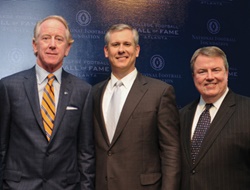The new Atlanta-based College Football Hall of Fame has 10 sponsors on board and several more that are close to signing, giving it more than $50 million in funding to get construction off the ground.
Builders will start constructing the hall of fame in downtown Atlanta in January or February with a targeted opening of fall 2014. Total cost of the facility is expected to be $66.5 million and organizers hope to cover the full amount in sponsorships and donations, although they will have access to credit from a variety of banking partners: BB&T, Regions and Fifth Third.
The list of sponsors is heavy, as expected, with companies that have ties to Atlanta or the state of Georgia. Among them are Atlanta-based Coca-Cola, AT&T, Chick-fil-A and the Chick-fil-A Bowl; Georgia Pacific; Georgia Power Foundation; and Brasfield & Gorrie, a global construction firm with headquarters in Birmingham, Ala., and a local
 |
Work on the College Football Hall of Fame will begin in January now that more than $50 million in sponsorships have been secured. National Football Foundation Chairman Archie Manning (left) is shown with Atlanta Hall Management interim CEO John Stephenson and NFF President and CEO Steve Hatchell.
Photo by: NATIONAL FOOTBALL FOUNDATION (2)
|
office in Atlanta. Brasfield & Gorrie built the Georgia Aquarium near the hall’s site.
Three other global companies have jumped on board as well: Kia Motors, Under Armour and Omni Hotels. Omni has a hotel property close to the hall’s site and will figure prominently in the catering business generated by the facility, while Kia has a plant in West Point, Ga.
Those initial 10 sponsors and two others the hall isn’t ready to name have committed $51.5 million, mostly through five-year, $5 million to $6 million commitments from each sponsor. A handful more are close to signing, said John Stephenson, interim CEO of Atlanta Hall Management, the organization overseeing the hall’s move from South Bend, Ind., to Atlanta.
“The intention is to clear the final $15 million that we need within the next two years,” Stephenson said.
The hall is selling three tiers of sponsorship for multiyear agreements, according to industry sources. The highest level, which comes with presenting sponsorship rights to certain galleries of the hall, goes for $1 million to $1.25 million per year, with the hall seeking five-year commitments that come with category exclusivity. A secondary level runs $500,000 annually, and a third tier of sponsorship costs around $250,000 a year.
Coca-Cola, Kia, Chick-fil-A and AT&T are believed to be at the high end. Their deals grant them either presenting sponsor rights or heavy integration into galleries that will feature players, coaches or other aspects of the game. Other sponsorships will align companies to areas such as the theater. It won’t be unlike the nearby Georgia Aquarium, which is segmented into separate themed areas with each having its own sponsor.
The details of which sponsor will be aligned with which section of the hall are still being worked out, said Stephenson, a corporate attorney who grew up in Atlanta and graduated from the University of Georgia.
Stephenson took the baton as the hall’s chief executive from Gary Stokan, president of the Chick-fil-A Bowl, who stepped aside a year ago. Stokan had overseen the first two years of the hall’s planning, but as the facility moved closer to becoming a reality, the strain of handling both jobs became too much, so Stokan relinquished his hall duties.
College Football Hall of Fame
■ Location: Atlanta
■ Projected cost: $66.5 million
■ Targeted opening: Fall 2014
■ Project manager: Cousins Property, Gude Management
■ Architect: TVS Design, Turner Associates
■ General contractor: Brasfield & Gorrie, Benchmark
■ Exhibit designer: Gallagher & Associates
■ Media production: Cortina Productions
Stephenson, who had been working on the hall’s business as an attorney with his firm, Troutman Sanders, took over as interim CEO and for the past year carried the project forward. The hall will be located next to the Georgia World Congress Center and within walking distance from other attractions, such as the World of Coke, the Georgia Aquarium, Georgia Dome and CNN Center.
“As a native Atlantan, I’ve looked at it from the perspective of, ‘Are we amplifying our already burgeoning tourism industry in downtown Atlanta?’” Stephenson said. “We had to figure out if we could really max this out and, if not, we just weren’t going to do it. … This had to be sold as an attraction, that has a hall of fame in it.”
Stephenson said the deals that have closed so far have been a collaborative sales effort among John Christie, the Hall’s CMO; Brad Olecki, vice president of sales; Stephenson; and Rick Jones’ Fishbait Marketing, which was brought on to extend the hall’s sales reach.
The hall’s business model projects 500,000 visitors a year, which is more than most halls of fame draw, but fewer than its neighbors, the World of Coke and Georgia Aquarium, bring in. Those attractions draw between 1 million and 2 million visitors a year.
“There was a healthy skepticism before, but there’s been a real effort from everyone involved to figure out how to make it more than a football museum,” said Steve Robinson, Chick-fil-A’s chief marketer. “It’s going to provide great hospitality opportunities, a media platform, a place for great events. The [National Football Foundation] has been patient with us, but we’re going to have something everyone can be proud of.”
Annual revenue from admissions, retail sales and events are projected to be $9.5 million, Stephenson said, with a full-time staff of 22 people. Sponsorship is built into the construction costs, but not the annual revenue numbers. That far surpasses the revenue that came into the previous College Football Hall of Fame in South Bend, which has been at that location since 1995. According to the National Football Foundation’s Form 990 for 2011, the College Football Hall of Fame revenue came in at $1.313 million, but only $177,314 of that came from admissions.
The not-for-profit hall is a licensing agreement between the rights holder, the National Football Foundation and the Georgia World Congress Center Authority. At 500,000 visitors a year, the hall will turn a tidy profit, Stephenson said, which will be reinvested into the facility. The facility’s break-even point is 380,000 visitors.
The NASCAR Hall of Fame, which opened in May 2010 in downtown Charlotte, attracted 272,000 visitors in its first year and is on pace for about 200,000 this year, despite projecting close to 800,000 for its opening year. That turned out to be a fraudulent projection that contributed to the demotion and eventual ouster of Tim Newman, the Charlotte Regional Visitors Authority’s CEO.
For sponsors, the baseline assets are visibility in the facility, a digital presence on the hall’s website, and promotional activation with the hall’s marks. The website, CFBHall.com, goes live this week.
There also could be hospitality opportunities when the enshrinement ceremony is held each July. The induction ceremony is annually held in New York in December, but the enshrinement is a separate function to honor the inductees at the hall site each summer.
Several potential assets are being evaluated by the hall and the National Football Foundation’s president and CEO, Steve Hatchell. One is the possibility of sublicensing video in the NFF’s archive and the names and likenesses of hall inductees.
Organizers also are preparing the facility to be a friendly site for media events, such as ESPN’s “College GameDay” or any other broadcasts that might originate from the hall. Stephenson said several areas of the building will be wired for broadcasts, but organizers decided not to build an actual studio because of the expense and the premium on space.





